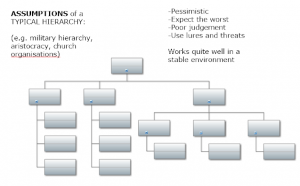0808
In Part 1 we introduced a key insight into what motivates people at work, meaning they have high job satisfaction. Learning about Frederick Herzberg’s ‘Motivator Factors’ was one of the most powerful tools I used while developing and managing numerous sales teams around Australia/NZ for 16 years. My teams were consistently high achieving, award winning, low maintenance and their motivation lasted. If you missed Part 1, I urge you to go back and read the article.
Too many organisations think carrots or sticks will motivate their people. They are working on ‘Hygiene Factors’ which, at best, stop employees feeling dissatisfied with their jobs. These factors are in the environment, expensive to maintain and only drive short term results with declining effect.
The ‘Motivator Factors’ is where the passion is. They are intrinsic to the job itself and live in the heart, enticing loyalty. Working on motivator factors in your business is driving the engine of motivation.
In order to see how this works (and doesn’t), we first look at the ‘dark side’….
Part 2 – How Traditional Organisations demotivate
Hierarchy/ Authoritarian
(Douglas Macgregor’s X-Y theory, 1960)
Traditional organisations are structured to meet the needs of the past Industrial Revolution. Hierarchical or authoritarian structure is severely out of step with the modern world of business and societal values. In these organisations I see a huge focus on Compliance. And while those organisations may achieve a finely tuned compliance culture, they will never elicit the loyalty and commitment of a passionate workforce.
This dynamic is not limited to large organisations though, because when a manager leaves a traditional organisation to go into business, he often manages his employees in a similar way. That is the model he has grown up with and a large organisation couldn’t get it wrong….right?
There are two theories that drive traditional organisations:
- Theory X is pessimistic: Employees are lazy and avoid work, so manage them by control and command.
- Theory Y is optimistic: Employees are responsible and want involvement in their work.
Chances are, there are twice as many organisations who take the view of Theory X.
Features:
- Control and command
- The centre is valued (at the top)
- Front-line is given low value
- Hierarchical war games
- Scarcity mentality (because it gets narrower as one is getting higher)
- Serve upwards (the boss is the customer)
- Information games (control the information going down)
- Breeds low trust
- Motivator factors are ignored
- Hygiene factors are used
Outcomes:
- Fear (the boss is our security, we serve the boss)
- Seething resentment
- Helplessness and dependency
- Broken hearts
- Obsession with hygiene factors – high cost
- LOST POTENTIAL of the front-line
People living in this environment feel sick inside, but it is the reality for thousands of organisations – who exhibit no faith in human nature. It is highly likely you have experienced an organisation or management like this.
What’s Next…
After this somewhat depressing edition you will be wondering if there is a bright side! The good news is that some organisations do operate so their people enjoy job satisfaction and are committed, loyal, achievement-driven and focussed on productivity…. an inspiring place to work oozing with passion. That’s next up!

